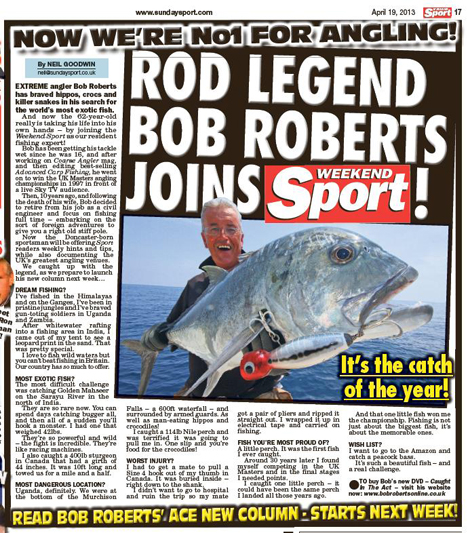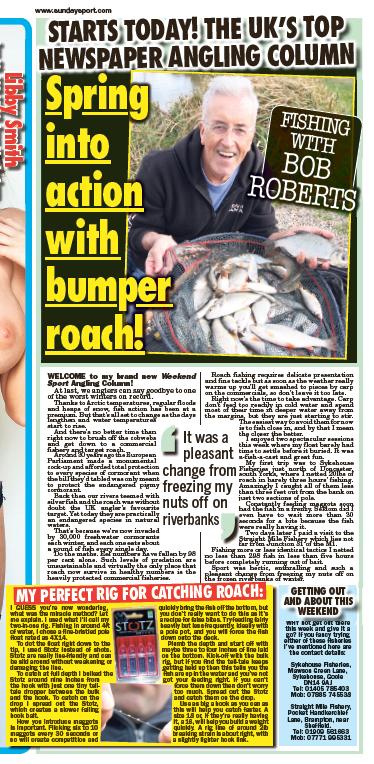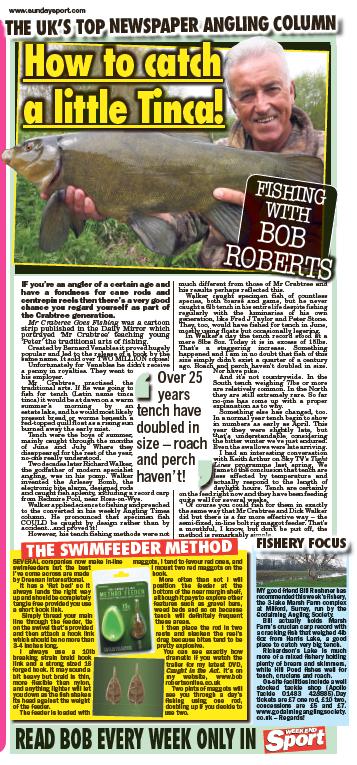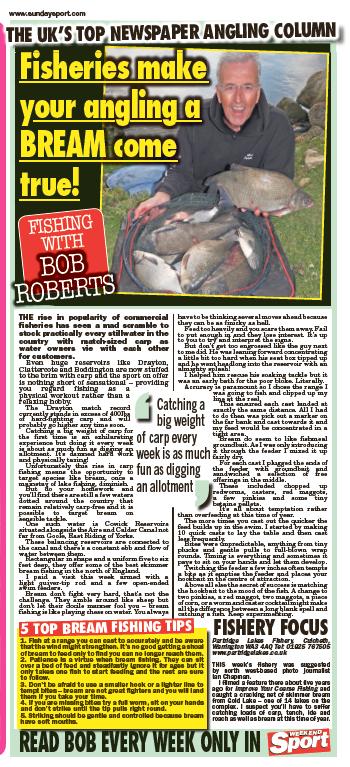Back in 2013 the Sunday Sport Newspaper launched an angling column and invited me to be their star columnist. It was an odd feeling. These are not opportunities that come your way every day. Indeed out of the thousands of wannabe angling writers out there I was the one selected, headhunted and signed up.
A year on and the column is still going strong and I receive nothing but positive feedback yet it seems such a waste to put effort into writing a column that in effect becomes next week’s chip paper. With this in mind I had a word with my editor and asked if I might publish the columns here on my web site and he said feel free, go ahead.
The beauty of being a year ahead means I can run them in synch, just a year behind. In other words the 16th June 2013 column can be published on 16th June 2014 and it will make perfect sense. This also means followers of my web site who haven’t read the Sport will get a fresh article each week. Those who can’t wait a year can buy the paper so it’s a win-win all round.
The column actually launched in April 2013 so I’ll do a quick catch up and give you a couple of bumper compilations. With a bit of luck I’ll be up to speed and publishing one a week by the beginning of July.
And so it begins
I was interviewed for the first column and awaited the outcome with trepidation. This was a red top with a reputation, after all, and even their own introduction stated I was taking my life into my own hands. Yes, the copy included an occasional innuendo and a little ‘puff’ to embellish my reputation as these things always do but all in all I was very happy. Neil Goodwin did a brilliant job and continues to do so today. Pretty remarkable for a self-confessed Leeds United fan!

The published text read:
EXTREME angler Bob Roberts has braved hippos, crocs and killer snakes in his search for
the world’s most exotic fish.
And now the 62-year- old really is taking his life into his own hands – by joining the Weekend Sport as our resident fishing expert!
Bob has been getting his tackle wet since he was 16, and after working on Coarse Angler mag, and then editing best-selling Advanced Carp Fishing, he went on to win the UK Masters angling championships in 1997 in front of a live Sky TV audience.
Then, 10 years ago, and following the death of his wife, Bob decided to retire from his job as a civil engineer and focus on fishing full time – embarking on the sort of foreign adventures to give you a right old stiff pole.
Now the Doncaster-born sportsman will be offering Sport readers weekly hints and tips, while also documenting the UK’s greatest angling venues.
We caught up with the legend, as we prepare to launch his new column next week…
DREAM FISHING?
I’ve fished in the Himalayas and on the Ganges, I’ve been in pristine jungles and I’ve braved gun-toting soldiers in Uganda and Zambia.
After whitewater rafting into a fishing area in India, I came out of my tent to see a leopard print in the sand. That was pretty special. I love to fish wild waters but you can’t beat fishing in Britain. Our country has so much to offer.
MOST EXOTIC FISH?
The most difficult challenge was catching Golden Mahseer on the Sarayu River in the north of India. They are so rare now. You can spend days catching bugger all, and then all of a sudden you’ll hook a monster. I had one that weighed 42lbs. They’re so powerful and wild– the fight is incredible. They’re like racing machines.
I also caught a 400lb sturgeon in Canada that had a girth of44 inches. It was 10ft long and towed us for a mile and a half.
MOST DANGEROUS LOCATION?
Uganda, definitely. We were at the bottom of the Murchison Falls – a 600ft waterfall – and surrounded by armed guards. As well as man-eating hippos and crocodiles! I caught a 114lb Nile perch and was terrified it was going to pull me in. One slip and you’re food for the crocodiles!
WORST INJURY?
I had to get a mate to pull a Size 4 hook out of my thumb in Canada. It was buried inside – right down to the shank. I didn’t want to go to hospital and ruin the trip so my mate got a pair of pliers and ripped it straight out. I wrapped it up in electrical tape and carried on fishing.
FISH YOU’RE MOST PROUD OF?
A little perch. It was the first fish I ever caught. Around 30 years later I found myself competing in the UK Masters and in the final stages I needed points. I caught one little perch – it could have been the same perch I landed all those years ago. And that one little fish won me the championship. Fishing is not just about the biggest fish, it’s about the memorable ones.
WISH LIST?
I want to go to the Amazon and catch a peacock bass. It’s such a beautiful fish – and a real challenge.
All I had to do was deliver interesting copy and hope the readers liked it. From now on it was all down to me. This is how I wrote my very first Sunday Sport column…
April 26th, 2013: SPRING INTO ACTION!
At last we anglers can say goodbye to one of the worst winters on record. Thanks to arctic temperatures, regular floods and heaps of snow, fish action has been at a premium but that’s all set to change as the days lengthen and water temperatures start to rise. There’s no better time than right now to brush off the cobwebs and get down to a commercial fishery and target roach.
30 years ago the European Parliament made a monumental cock-up and afforded total protection to every species of cormorant when the tabled bill was only meant to protect the endangered pigmy cormorant. Back then our rivers teemed with silver fish and the roach was without doubt the UK angler’s favourite target yet today they are practically an endangered species in natural waters.
That’s because we are now invaded by 30,000 freshwater cormorants each winter and each one eats approximately a pound of fish every single day. Do the maths. Eel numbers have fallen by 98 per cent. Such levels of predation are unsustainable and virtually the only place that roach now survive in healthy numbers is the heavily protected commercial fisheries.
Roach fishing requires delicate presentation and fine tackle but as soon as the weather really starts to warm up you’ll get smashed to pieces by carp on the commercials so don’t leave it too late. Right now’s the time to take advantage. Carp don’t feed too readily in cold water and spend most of their time in deeper water away from the margins but they are just starting to stir. The easiest way to avoid them for now is to fish close in and by that I mean the closer the better.
I enjoyed two spectacular sessions this week where my float barely had time to settle before it buried. It was a fish a cast and great fun. My first trip was to Sykehouse Fisheries just north of Doncaster where I netted 20lbs of roach in barely 3 hours fishing. Amazingly I caught all of them less than 3 feet out from the bank on just two sections of pole. Feeding maggots soon had the fish in a frenzy. Seldom did I even have to wait more than 30 seconds for a bite because the fish were really having it.
Two days later I paid a visit to the Straight Mile fishery which lies not far from Junction 31 of the M1. Fishing more or less identical tactics I netted no less than 298 fish in less than five hours before completely running out of bait. Sport was hectic, enthralling and such a pleasant change from freezing my nuts off on the frozen river banks which is what I seemed to spend most of last winter doing.
I guess you’re now wondering, what was the miracle method? Let me explain. I used what I’ll call my two-in-one rig. Fishing in around 4 feet of water I chose a fine bristled pole float rated as 4X14. To dot the float right down to the tip I used a product called Stotz instead of shots. Stotz are really line-friendly can be slid around without fear of weakening or damage.
To catch at full depth I bulked the Stotz around 9 inches from the hook with just one tiny tell-tale dropper between the bulk and the hook.
To catch on the drop I spread out the Stotz which creates a slower falling hook bait.
How you introduce your maggots is very important. Flicking six to 10 maggots every 30 seconds or so will create competition and quickly bring the fish off the bottom but you don’t really want to do this as it’s a recipe for lots of false bites. Try feeding fairly heavily but less frequently, ideally with a pole pot, and you will force the fish down onto the deck where you want them.
Plumb the depth and start off with maybe 3 to 4 inches of line laid on the bottom. Kick off with the bulk rig but if you find the tell-tale keeps getting held up then this tells you the fish are up in the water and you’ve not got your feeding right. If you can’t force them down then don’t worry too much. Spread out the Stotz and catch them on the drop.
One final tip, use as big a hook as you can get away with because this will help you catch faster. A size 18 or if they’re really having it, a 16, will help you build a weight quickly. A rig line of around 2lb breaking strain is about right with a slightly lighter hook link.
Why not get out there this week and give it a go?
If you fancy trying either of these fisheries here are the contact details:
Sykehouse Fisheries, Mawson Green Lane, Sykehouse, Goole DN14 9AJ
Tel: 01405 785403 Mob: 07885 745538
Straight Mile Fishery, Pocket Handkerchief Lane, Brampton, near Sheffield.
Tel: 01909 561663 Mob: 07771 995331
Interestingly Neil suggested I should include a little more technical detail in the column which was a rather pleasant surprise. Until now I was fearing they might want more about whips, short poles and spraying. Maybe they did actually want a fishing column after all. Wow! That was a result…
From here on in the format is going to become familiar. I’ll publish a page image as it appeared in the Sport and then the actual text I submitted (in blue font). If you’re happy with the layout then that’s how it will be from now on.
May 3rd, 2013: YOU LITTLE TINCA
If you’re an angler of a certain age and have a fondness for cane rods and centrepin reels then there’s a very good chance you regard yourself as part of the Crabtree generation. Mr Crabtree Goes Fishing was a cartoon strip published in the Daily Mirror which portrayed Mr Crabtree teaching young Peter the traditional arts of fishing. Created by Bernard Venables it proved incredibly popular and led to the release of a book by the same name. It sold over 2 MILLION copies!
Unfortunately for Venables he didn’t receive a penny in royalties. They went to his employer.
Crabtree practised the traditional arts. If he was going to fish for tench (Latin name tinca tinca)it would be at dawn on a warm summer’s morning by an estate lake and he would most likely present bread or worms beneath a red-topped quill float as a rising sun burned away the early mist.
Tench were the boys of summer, mainly caught through the months of June and July. Where they disappeared for the rest of the year no-one really understood.
Two decades later Richard Walker, the godfather of modern specialist angling was in his pomp. Walker invented the Arlesey Bomb, the electronic bite alarm, designed rods and caught fish aplenty including a record carp from Redmire Pool. Walker applied science to fishing and preached to the converted in his weekly Angling Times column. He pronounced that specimen fish could be caught by design rather than by accident and proved it.
However his tench fishing methods were not much different from those of Mr Crabtree and his results perhaps reflected this. Walker caught specimen fish of countless species, both coarse and game, but he never caught a 6lb tench in his entire life despite fishing regularly with the luminaries of his own generation, Fred J Taylor and Peter Stone included. They, too, would have fished for tench in June, mostly using floats but occasionally legering.
In Walker’s day the tench record stood at a mere 8lbs 8oz. Today it is in excess of 15lbs. That’s a staggering increase. Something happened and I am in no doubt that fish of this size simply didn’t exist a quarter of a century ago. Roach and perch haven’t doubled in size. Nor have pike. And it’s not country-wide. In the South tench weighing 7lbs or more are relatively common. In the North they are still extremely rare. So far no-one has come up with a satisfactory explanation as to why.
Something else has changed, too. In a normal year tench begin to show in numbers as early as April. This year they were slightly late but that’s understandable considering the bitter winter we’ve just endured. Even the swallows were late arriving.
I had an interesting conversation with Keith Arthur on Sky TV’s Tight Lines programme last spring. We came to the conclusion that tench are less affected by temperature and actually respond to the length of daylight hours. Tench are certainly on the feed right now and they have been feeding quite well for several weeks.
Of course you could fish for them in exactly the same way that Mr Crabtree and Dick Walker did but there is a far more effective way – the semi-fixed, in-line bolt rig maggot feeder. That’s a mouthful, I know, but don’t be put off, the method is remarkably simple.
Several companies now make in-line swimfeeders but the best I’ve come across are made by Drennan International. It has a ‘flat bed’ so it always lands the right way up and should be completely tangle free providing you use a short hook link.
Simply thread your main line through the feeder, tie on the swivel that’s provided and then attach a hook link which should be no more than 3-4 inches long. I always use a 10lb breaking strain braid hook link and a strong sized 16 forged hook. It may sound a bit heavy but braid is thin, more flexible than nylon and anything lighter will let you down as the fish shakes its head against the weight of the feeder.
The feeder is loaded with maggots, I tend to favour red ones, and I mount two red maggots on the hook. More often than not I will position the feeder at the bottom of the near margin shelf although it pays to explore other features such as gravel bars, weed beds and so on because tench will definitely frequent these areas. I then place the rod in two rests and slacken the reel’s drag because bites tend to be pretty explosive. You can see exactly how dramatic if you watch the trailer for my latest DVD, Caught in the Act. It’s on my web site, www.bobrobertsonline.co.uk
Two pints of maggots will see you through a day’s fishing using one rod, doubling up if you decide to use two.
Fishery Focus
My good friend Bill Rushmer has recommended this week’s fishery, the 3-lake Marsh Farm complex at Milford, Surrey, run by the Godalming Angling Society. Bill actually holds Marsh Farm’s crucian carp record with a cracking fish that weighed 4lb 6oz from Harris Lake. Harris is a good place to target if you want to catch very big tench. Richardson’s Lake is much more of a mixed fishery holding plenty of bream and skimmers while Hill Pond fishes well for smaller tench, crucians and roach.
On-site facilities include a well stocked tackle shop (Apollo Tackle 01483 428885) The shop also serves food.
Day tickets are £7 one rod, £10 two, concessions are £5 and £7.
Web site: www.godalminganglingsociety.co.uk
Two columns in and it felt like I was on a roll. Funny how quickly you get your feet under the table. Suddenly it wasn’t so daunting after all. On to the next weekend…
10th May, 2013: STEP BACK IN TIME
The rise in popularity of commercial fisheries has seen a mad scramble to stock practically every stillwater in the country with match-sized carp as water owners vie with each other for customers. Even huge reservoirs like Drayton, Clattercote and Boddington are now stuffed to the brim with carp and the sport on offer is nothing short of sensational, providing that is you regard fishing as a physical work-out rather than a relaxing hobby. The Drayton match record currently stands in excess of 400lbs of hard-fighting carp and will probably go higher any time soon.
Of course, catching a big weight of carp for the first time is an exhilarating experience but doing it every week is about as much fun as digging an allotment. It’s damned hard work and physically taxing!
Unfortunately this rise in carp fishing means the opportunity to target species like bream, once a mainstay of lake fishing, diminish. But do your homework and you’ll find there are still a few waters dotted around the country that remain relatively carp-free and where it is possible to target bream on sensible tackle.
One such water is Cowick Reservoirs situated alongside the Air and Calder Canal not far from Goole. These balancing reservoirs are connected to the canal and there’s a constant ebb and flow of water between them. Rectangular in shape and a uniform 5 to 6 feet deep they offer some of the best skimmer bream fishing in the North of England.
I paid a visit this week armed with a light quiver tip rod and a few open ended feeders. Bream don’t fight very hard, that’s not the challenge. They amble around like sheep but don’t let their docile manner fool you, bream fishing is like playing chess on water. You always have to be thinking several moves ahead because they can be as finicky as hell. Feed too heavily and you scare them away. Fail to put enough in and they lose interest. It’s up to you to try and interpret the signs.
But don’t get too engrossed like the guy next to me did. He was leant forward concentrating a little bit too hard when his seat box tipped up and he went headlong into the reservoir with an almighty splash! I helped him rescue his soaking tackle but it was an early bath for the poor bloke, literally.
Accuracy is paramount so I chose the range I was going to fish and clipped up my line at the reel. This ensured each cast landed at exactly the same distance. All I had to do then was pick out a marker on the far bank and cast towards it and my feed would be concentrated in a tight area.
Bream do seem to like fishmeal groundbait. As I was only introducing it through the feeder I mixed it up fairly dry. For each cast I plugged the ends of the feeder with groundbait and sandwiched a selection of free offerings in the middle. These included chopped up redworms, casters, red maggots, a few pinkies and some tiny betaine pellets. It’s all about temptation rather than over feeding at this time of year.
The more times you cast out the quicker the feed builds up in the swim. I started by making ten quick casts to lay the table and then cast less frequently. Bites were unpredictable, anything from tiny plucks and gentle pulls to full blown wrap rounds. Timing is everything and sometimes it pays to sit on your hands and let them develop. Twitching the feeder a few inches at a time often provokes a bite as it empties the feeder and places your hookbait right in the centre of attraction.
Above all else the secret of success is matching the hookbait to the mood of the fish. Bream are decidedly finicky feeders, more so in this cold spring, so a change to two pinkies, a red maggot, two maggots, a piece of corn, or a worm and caster cocktail might make all the difference between a long blank spell and catching a fish. Sometimes you need to use a longer hook length or a smaller hook.
That’s bream fishing folks and if you don’t read the signs and adapt accordingly then you’ll struggle. Keep experimenting until you decode the puzzle and you’ll have a fabulous day like I did.
5 Top Bream Fishing Tips
1. Fish at a range you can cast to accurately and be aware that the wind might strengthen. It’s no good getting a shoal of bream to feed only to find you can no longer reach them.
2. Patience is a virtue when bream fishing. They can sit over a bed of feed and steadfastly ignore it for ages but it only takes one fish to start feeding and the rest are sure to follow.
3. Don’t be afraid to use a smaller hook or a lighter line to tempt bites – bream are not great fighters and you will land them if you take your time.
4. If you are missing bites try a full worm, sit on your hands and don’t strike until the tip pulls right round.
5. Striking should be gentle and controlled because bream have soft mouths.
Fishery Focus
Partridge Lakes Fishery, Culcheth, Warrington WA3 4AQ Tel: 01925 767505 www.partridgelakes.co.uk/
This week’s fishery was suggested by North West based photo journalist Ian Chapman. I filmed a feature there about 5 years ago for Improve Your Coarse Fishing and caught a cracking net of skimmer bream from Gold Lake, one of 14 lakes on the complex, using very similar tactics to those described here although I must point out that it was in the winter. I suspect you’ll have to suffer catching loads of carp, tench, ide and roach as well as bream at this time of year. Tough eh?
The on-site cafe provides hot and cold food throughout the day should you get hungry.
Well, that’s a start. I shall get the next bunch of articles up ASAP so I can then drop into a weekly publication schedule. Hope you like it. Don’t be shy of leaving feedback.
Tight lines, Bob Roberts



